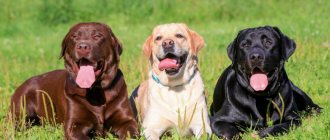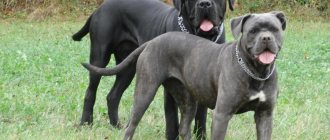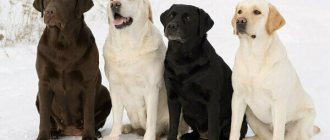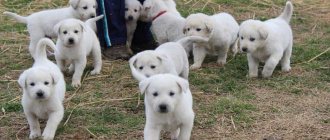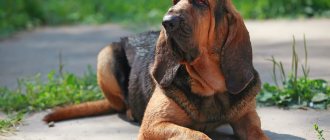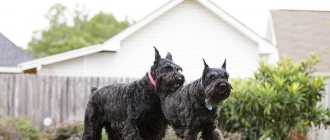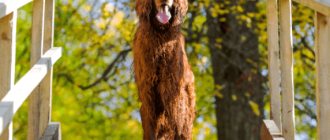History of the Labrador Retriever breed
Labrador Retriever
Whatever geographic associations you may have, researchers have not found a direct connection between Labradors and the North American peninsula of the same name. The version of the origin of the breed from the island of Newfoundland, located southeast and now part of the youngest Canadian province, is considered historically reliable.
The origin of the name of the breed is explained by different theories. According to one, the original color (exclusively black) resembled the igneous rock found in their homeland - labradorite. Supporters of the other argue that Europeans, who were not particularly versed in the intricacies of toponymy of the New World, considered such a name apt for animals that arrived on ships from the shores of the Labrador Sea. It is likely that an elementary need arose to distinguish between the new breed and the longhaired Newfoundland, well known to British breeders of the 19th century. However, there is an opinion that both breeds appeared in England at about the same time and, as a result of confusion, the “natives” from Labrador were named after the neighboring island and vice versa.
By the way, it is assumed that the ancestor of the shaggy giant Newfoundlands was closely related to the ancestor of the Labradors - St. John's water dog. Explore the origins of Water Dog St. itself. John's is not possible due to the long-standing history, but experts admit that it was the result of crossing a large number of breeds that, together with their owners, ended up in North America since the Great Geographical Discoveries.
The first European explorers of the modern coast of Canada were Portuguese sailors, and it is likely through their efforts that Can Diaguas, Portuguese water dogs, bred in the Middle Ages to make life easier for sailors, appeared here. They served as postal couriers between ships of fishing fleets, delivered messages ashore, pulled out things that were overboard, and even helped drive schools of cod into nets. St. John's dogs also excelled in deep water and were used by Canadians to search for and rescue victims of shipwrecks. A series of short-sighted restrictive laws and prohibitively high taxes on dog owners led to a decline in the number of animals, and then to their extinction. The last representatives of this breed died in the 20th century, but its genes live on in Golden Retrievers, Labradors, Chesapeake Bay Retrievers, and Flat-Coated Retrievers.
Labrador puppy
The first Labradors arrived in Europe on merchant ships. For a long time, strong economic ties were established between Newfoundland and England; here Canadians sold cod caught in the Atlantic. The British, passionate lovers of hunting, immediately paid attention to the agile and easy-to-train sailor companions. In the 19th century, the importation of “small Newfoundland dogs” began. The name of the breed that is accepted today only appeared in the 1870s. At the same time, the influx of overseas “fresh blood” began to dry up, and in 1895 the Quarantine Act was adopted, which prohibited the import of animals without a license and a six-month quarantine. From then on, the breed developed virtually exclusively thanks to internal selection.
The first breeders of Labradors, independently of each other, were two noble families - the Earls of Malmesbury and the Dukes of Buccleuch. Kennels located in Hampshire and Scotland respectively helped popularize the breed among local aristocrats. It turned out that short-haired workers from the island of Newfoundland are ideal companions for hunting birds and small game. In addition to endurance and a gentle disposition, with proper upbringing, they were complemented by amazing skills in finding and apporting prey shot by the owner. The success of Labradors was later facilitated by good exhibition qualities.
For several decades, confusion reigned with the definition of belonging to one or another breed. It happened that even puppies from the same litter were classified in documents as different “branches” of retrievers. However, already in 1903, Labradors were officially recognized by the oldest kennel club in the world, the English Kennel. This caused another surge of interest and led to the creation of several new nurseries. In 1916, the Labrador Retriever Club was formed, an organization that still operates today, caring about maintaining the purity of lines.
During the First World War, Labradors crossed the ocean again. In the USA they quickly gained popularity, and the so-called American type gradually emerged, about which there is still debate among experts.
For a long time, black was considered the only acceptable color for an animal; other puppies were discarded. The fawn Labrador Retriever was first registered in 1899, and the chocolate Labrador Retriever was registered in 1930.
Chocolate Labrador
Fawn Labrador
How to accustom to a home environment
Keeping a Labrador puppy in an apartment will not bring any particular difficulties. Children quickly get used to new things; it is enough to accustom them to a diaper and quickly take them outside, after sleep, to the toilet.
- Puppies are initially clean; it is worth giving a little guidance and setting boundaries. You can punish only immediately after the offense, if you did not see how the puddle appeared in the wrong place, you can no longer scold.
The puppy will not understand how and when he did something wrong, prepare yourself mentally for all the difficulties, take them for granted. In 2 - 4 weeks he will get used to it, and when he finally matures, there will be no problems. The main thing is to beckon about the need for early education and control over actions from an early age.
Should it be kept in a cage?
Labrador retrievers and dogs in general perceive the crate as their place where they feel comfortable. They feel protected in the cage, without perceiving it as punishment. Instead of a bed or nest, you can put a cage where there will be a warm bed for the puppy.
During your absence, the cage is closed, the animal is released immediately after the owner comes home. He can't spend all his time in a cage. It is better to keep babies in a playpen, and after 3 months transfer them to a cage.
For punishment or restriction - the cage is not used, only during your absence; the time when the dog is closed should not exceed 4 hours.
Appearance of Labradors
Most reputable breeders are guided by the FCI standard, the new edition of which was adopted in January 2011.
General impression
Strong build, compact, very active.
Head
Well balanced, not too massive or thin-boned. The skull is wide, the muzzle without large cheeks. The transition from the main part of the head to the muzzle is clearly defined. The nose is wide, with well-defined nostrils. Jaws of medium length, strong. The Labrador's teeth are set vertically in the jaws, the bite is perfect and scissor-shaped (the upper incisors completely overlap the lower ones). Medium-sized eyes, brown or hazel, express intelligence and good character. The ears are not wide or heavy, hanging, close to the head and set far back.
Neck
Clean lines, powerful and strong.
Labrador muzzle
Frame
Straight, horizontal topline. Wide, short and strong loin. The chest is wide and deep, with well-arched ribs.
Forelegs
Black Labrador
Well boned, straight from elbow to ground. The shoulder is long and oblique. Long blades with an angle of inclination that provides a wide pitch (90-105°). The feet are round, compact, with well-developed pads and arched toes.
Hind limbs
Well developed, without sloping the croup towards the tail. Knees with good angles (110° provide an ideal structure for normal movement of the rear part of the body). The hock joint is low. The structure of the paws is similar to the forelimbs.
Tail
Cute fawn labrador puppy
The tail of a Labrador is very thick at the base, gradually tapering towards the end - a characteristic “otter” shape. The length is average. Without dewlap, but covered on all sides with short, thick, dense hair. Carried low, level with the topline, never curled over the back.
Movements
Free, productive. Straight and parallel fore and hind legs.
Wool
The Labrador's coat is short, thick, without waves or fringes, and hard to the touch. The undercoat is thick and protects from bad weather.
Color
Labradors have solid colors: black, fawn or brown (liver, chocolate). Fawn from light cream to fox red. A small white spot on the chest is acceptable.
Size
The ideal height at the withers for males is 56-57 cm, for females 54-56 cm. Recently, many individuals whose height reaches only 50 cm have appeared in Europe. This trend is of serious concern to experts. The weight of Labradors is not regulated by the standard, but the preferred range for males is 29-36 kg, for females 25-32 kg.
It must be remembered that externally, Labradors differ not only in unofficial types (English or American; old, classic, heavy, modern and others), but also depending on whether you are looking at a show dog intended for exhibitions and performances, or a “working” dog. " The former are heavier and have shorter legs, while the latter are athletically built.
Vaccinations, susceptibility to diseases
Labrador is a strong dog with no special health problems. As a rule, regular prophylaxis is enough to avoid starting treatment. An annual examination by a veterinarian is required for early detection of the disease.
The breed is prone to diseases such as:
- hip dysplasia;
- elbow dysplasia;
- obesity (dogs are prone to overeating);
- panosteitis is a disease of young dogs associated with rapid growth;
- osteochondrosis – most often affects the shoulder, knee and hock joints;
- progressive retinal atrophy, cataracts;
- licking granuloma - the formation of ulcers on the leg caused by idiopathic licking (fawn-colored individuals are more often affected);
- epilepsy (not common in Labradors).
Treatment against worms
Labradors are dewormed once a quarter and 10 days before vaccination. Worms are removed from bitches 2 weeks before mating. Before giving the drug, you need to carefully study the instructions and follow them strictly.
It is important to know exactly the dog’s weight, because the dosage of the drug is based on this parameter. Overdose is especially dangerous for puppies. It can even lead to the death of the animal. And an insufficient amount of the drug will not give the desired effect.
Vaccinations, first vaccination
Only healthy individuals are vaccinated. After administration of the drug, the puppies are observed for about 6 hours. It is necessary to monitor whether swelling of the nasopharynx or other symptoms of an allergic reaction have appeared. If they are present, the dog is given an antihistamine.
Vaccination schedule:
- 2 month old puppies (Nobivac DHPPi with Nobivac Lepto or Eurican DHPPI2-L)
- after 3-4 weeks (again with the same vaccine);
- at 6-7 months, after the final change of teeth (together with the rabies vaccine Nobivac DHPPi+R+L)
Adult dogs are vaccinated annually against leptospirosis, parvovirosis, plague and rabies. Only rabies vaccination is mandatory. The rest are given at the discretion of the owner.
Photo of an adult Labrador
Labrador Retriever Personality
It is difficult to find a dog with a lighter and more amiable character than the Labrador Retriever. They are incredibly friendly and try to please a person in any situation. Aggression is completely unusual for them, so there will be no problems living in a house where there are other animals (including cats) and children of any age.
Guess who's the captain here?
The downside of such a gentle disposition can only be called poorly developed security qualities. You shouldn’t expect a Labrador to fight back against robbers - everyone who comes to its territory is by default perceived as a new playmate, but in the event of a direct threat to its owners from people or “strange” dogs, it will definitely come to the defense.
Labrador Retrievers make excellent guide dogs for the visually impaired, therapists for those with autism, and assistants for people with disabilities. In addition, they are often used as service dogs during rescue operations (particularly on water), and their keen sense of smell helps in detecting explosives and drugs.
For generations, they have had the instinct of gun dogs to find and bring shot game to their owner. If hunting is not one of your hobbies, to make your dog happy, it is enough to regularly fetch balls and sticks thrown away. It's great fun and a workout that burns calories.
Description and features
The Labrador Retriever breed is native to Canada. It was from there that its representatives emigrated to the English islands, where breeders began to actively breed them. Scientists still do not agree on the exact origin of the dog. According to one version, his closest ancestor is the famous Newfoundland, a diving dog.
According to another vision, the Labrador Retriever breed was born as a result of crossing different breeds of dogs that belonged to the Vikings. The first version has a compelling argument - modern representatives of the breed love to swim, just like Newfoundlands. This suggests a related origin.
Labrador dogs have no aggression at all
The interesting thing is that retrievers do an excellent job both on land and on water. Not every dog can boast of such versatility. The dog in question is an ideal swimmer. He feels comfortable even at depth, without any fear of drowning. In addition, he can also be called an excellent diver.
In the first half of the 19th century, the British began breeding Labradors en masse in order to popularize them. Even then, people noticed that these are very kind dogs, from which not even a minimal threat comes. This is absolutely true. One of the reasons why large families from all over the world choose this representative of the fauna as a pet is its good nature.
It is this quality of the dog that has won the hearts of millions of people. These charming dogs are always found at animal exhibition events and almost always take prizes there. They are artistic, playful and friendly. The public really likes these animals.
Modern retrievers are used in the police service. They have an excellent sense of smell, which allows them to quickly find drugs, even well hidden ones. In fact, they have more skills than it seems. Labrador is a good hunter, guide and rescuer.
The good nature and determination of the animal made it universal in terms of serving people. But there is a “job” that it definitely cannot handle – protecting people and territories. The retriever is completely devoid of aggression, therefore, it will not be able to detain a criminal, even an armed one.
Education and training
Labradors are incredibly active and cheerful creatures; even as adults they love active games. High intelligence and calm character open up wide opportunities for training. It is not recommended to be too harsh. You should be persistent but patient, do not forget about encouragement (both verbal and with treats) and avoid boring, monotonous activities in which the pet inevitably loses interest in the process.
Early socialization is extremely important so that your dog does not experience stress when in contact with the outside world, other people, animals, and also firmly understands acceptable standards of behavior in various life situations. Labrador owners who do not have experience raising large dogs are better off seeking help from professional dog trainers and taking several lessons or completing a full course of training.
Labrador training
Truth and myths about the breed
You can often hear that dogs of this breed are trained to be guide dogs because they do not require long training for this. They say they are born ready-made trained dogs. It is a myth! No, dogs are first carefully selected for their temperament, and then trained for a long time, systematically over several years.
Animals are trained, taught complete obedience and tolerance. And only then are they handed over to blind people as assistants. And representatives of the Labrador breed are chosen for this role because of their good-natured nature, tolerance and complete lack of aggression towards humans.
The love of water and bathing has served to spread another myth. They say that dogs of this breed are excellent swimmers and will not miss a single body of water without swimming in it. Special membranes between the toes help animals swim well. Dogs can dive and retrieve objects from the bottom of a pond. It is so beautiful!
In reality, everything looks like this - these dogs will climb into any ditch, puddle, or swampy pond and will happily swim there, despite the owner’s dissatisfaction. Not everyone will like this animal behavior. Thick wool does not get wet, and dogs are not afraid of dirt. To be fair, we note that dogs also bathe in clean water with great pleasure; they can sit in the master’s bathroom for hours or jump into an ice hole in winter.
Care and maintenance
The main commandment of the owner of a Labrador Retriever from the first days should be the principle of moderation in food. The fact is that these dogs are prone to overeating, which leads to obesity and very serious health problems. To avoid troubles, accustom your dog to a strict diet, monitor the volume of portions, do not allow excess “lunch” to remain in the bowl, do not get carried away with dog treats and, of course, do not treat your pet with pieces from the common table - salty, smoked and sweet food . If you prefer natural nutrition, agree on the menu with your doctor and do not forget about vitamin and mineral supplements. When choosing ready-made food, focus on products from trusted brands from the upper price segment. With any type of diet, the dog must have constant access to fresh drinking water.
Food, food, food!
As already mentioned, Labradors are very active; regular physical activity is not just desirable for them, but is a prerequisite for normal well-being and psychological state. Get ready for long walks - experienced breeders advise spending half an hour on them in the morning and at least two hours in the evening. In this case, the dog will not get bored, gain excess weight and pester you with pranks in the apartment.
Caring for a Labrador does not require extra effort. Basically we are talking about standard procedures:
- brushing - daily during the period of active shedding, which occurs twice a year, and once or twice a week the rest of the time, it is recommended to use a special hard brush;
- washing - under normal conditions it is enough to do this once every two months, using products recommended by the veterinarian. Frequent water procedures negatively affect the condition of the coat and skin, as well as immunity;
- brushing teeth regularly, with a special toothpaste for dogs;
- Ear care – to avoid infections, it is necessary to systematically examine the ears and remove dirt with a cotton swab.
It is important, of course, to closely monitor your pet and not postpone a visit to the veterinarian if signs of poor health or atypical behavior are noticed.
Walking and exercise
The need for movement is in the Labrador's blood. He was bred for hunting. Moreover, it does not work like a husky - at a distance from the hunter, but very close to the person. Contact with the owner is important for the breed. Active walks provide your pet with such closeness.
It’s not enough for Labru to walk sedately through the park on a leash. Outdoor games are what a Labrador Retriever needs to stay healthy. The breed description contains this information. If there is no suitable company for your pet in the area, the owner should take on the role of play partner.
Loads need to be dosed. There is no need to exhaust a small puppy during walks so that he falls dead as soon as he crosses the threshold of the apartment. A growing pet cannot move as actively as an adult dog. Gradually the load is increased.
The ideal type of exercise for a puppy is swimming. All muscle groups work, while the load on fragile joints is not significant. It is useful for dogs to move in shallow water. In winter, ponds will be replaced by snowdrifts. Driving through deep snow is a good alternative to swimming.
Labrador Health and Diseases
In general, Labrador retrievers can be called fairly healthy dogs, although any purebred animals, due to the limited choice of lines, have a predisposition to certain genetic diseases.
From birth or with age, some individuals may develop autoimmune diseases or deafness. But in most cases, until old age, visits to the clinic will be sporadic. Puppies must undergo routine vaccinations if this has not been done by the breeder. With proper care and proper nutrition, the average life expectancy of this breed is 10-12 years. Like other large dogs, the Achilles heel of Labradors is the musculoskeletal system; veterinarians call the most common disease hip dysplasia. Cases of cataracts, retinal atrophy and corneal dystrophy are common.
But the main source of danger to a dog’s health is obesity due to an insatiable appetite, which was already mentioned above. This factor affects the length and quality of life of the pet, as it inevitably leads to the development of diabetes, eye diseases, and diseases of the musculoskeletal system. A controlled diet and adequate exercise will help your pet stay active and healthy longer.
Photo gallery
If you cannot determine whether your pet is a Labrador, you can contact the kennel club and consult or compare your dog with the photographs that we have selected especially for you.
How to choose a puppy
The popularity of the breed is not always an advantage for those who decide to get a Labrador Retriever.
In pursuit of profit, unscrupulous breeders keep parents and puppies in inappropriate conditions. Of course, unsanitary conditions, overcrowding and poor nutrition have a detrimental effect on the development of a growing organism and health in the long term, so the first piece of advice: do not try to save money and contact only nurseries with a good reputation, where you can see your future pet with your own eyes and get acquainted with pedigree documents , get reliable information about vaccinations. When choosing a Labrador, pay attention to compliance with the external characteristics of the breed, observe the baby’s behavior - he should be playful, active and easy to contact. Important signs of good health are a healthy shine to the coat, clean eyes and ears, and a normal appetite.
Primary puppy socialization
Once a little Labrador arrives in a new apartment, it will take time to get used to the environment. Gradually accustom him to a place to sleep and a place to eat. When sending to the place, give the appropriate command.
Demarcate the territory; a bed and a place for eating are different places. Disposable diapers are placed much further from the sleeping area.
You will need to train your puppy to:
- New nickname, call him by name as often as possible;
- Wearing a collar and walking on a leash (start with a short time, put on the collar and leash before
- every time you go outside, at home, all the equipment is removed);
- At first, carry it in your arms; the puppy should not go down the stairs on his own;
- Go outside at least 3-4 times, preferably immediately after sleeping and feeding;
- Accustom to new sounds: TV, car noise, crowded places;
- Loud sounds: thunder, rain, thunderstorm, fireworks, screaming children, music;
- Visit crowded places as often as possible;
- Change routes;
- Take it with you to the store.
After 2 weeks or 5-7 days, start your first lessons on learning commands. The simplest ones are taken, on their basis all training in the future will be built:
- It is forbidden;
- Sit;
- Place;
- Wait;
- Ugh;
- Lie;
- Voice.
If you are planning to take your Labrador hunting, read our article about the peculiarities of upbringing in advance. As soon as you have learned the first commands, move on to more complex ones, increasing the time of training; more about the nuances of training below.
Photos of Labrador puppies
How much does a Labrador Retriever cost?
The most affordable offers are “hand-off” puppies, without documents and pedigree, but we remind you once again: this way you risk becoming the owner of a dog with poor health or completely devoid of the “trademark” qualities of a Labrador due to the admixture of unknown genes.
A child with papers who cannot count on participation in exhibitions due to more or less significant defects in appearance will cost from 20 to 35 thousand rubles. Of course, this moment does not matter if you just dream of an affectionate and devoted friend for the whole family.
Dogs of the so-called show class, whose parents are recognized champions, and whose characteristics exactly correspond to the breed standard, are much more expensive - in the range of 40-60 thousand rubles. In this case, you will be able to present your pet to a strict court of experts and hope for prizes.
Origin story
The birthplace of Labradors is the island of Newfoundland in Canada. The history of the breed is shrouded in mystery and speculation. Exact information has not been preserved. It came to Europe at the beginning of the 19th century. In fact, this is a smaller copy of the black Newfoundland, created in order to get fish out of the water that have fallen off a hook or escaped from a net. The dogs also hunted birds with the same success.
Since the name "Newfoundland" was already taken, the breed was given the name "Labrador". The word "labrador" is translated as "worker". Representatives of the breed are truly hard-working. This is not the only version. It is believed that the name comes from the black labradorite stone, or from the Portuguese village of Castro Laboreiro, where dogs similar to Labradors are found.
Today it is the most popular breed in the United States. Labras serve in the police and customs. They work as guides and take part in the rehabilitation of patients. But most of them are just pets.
